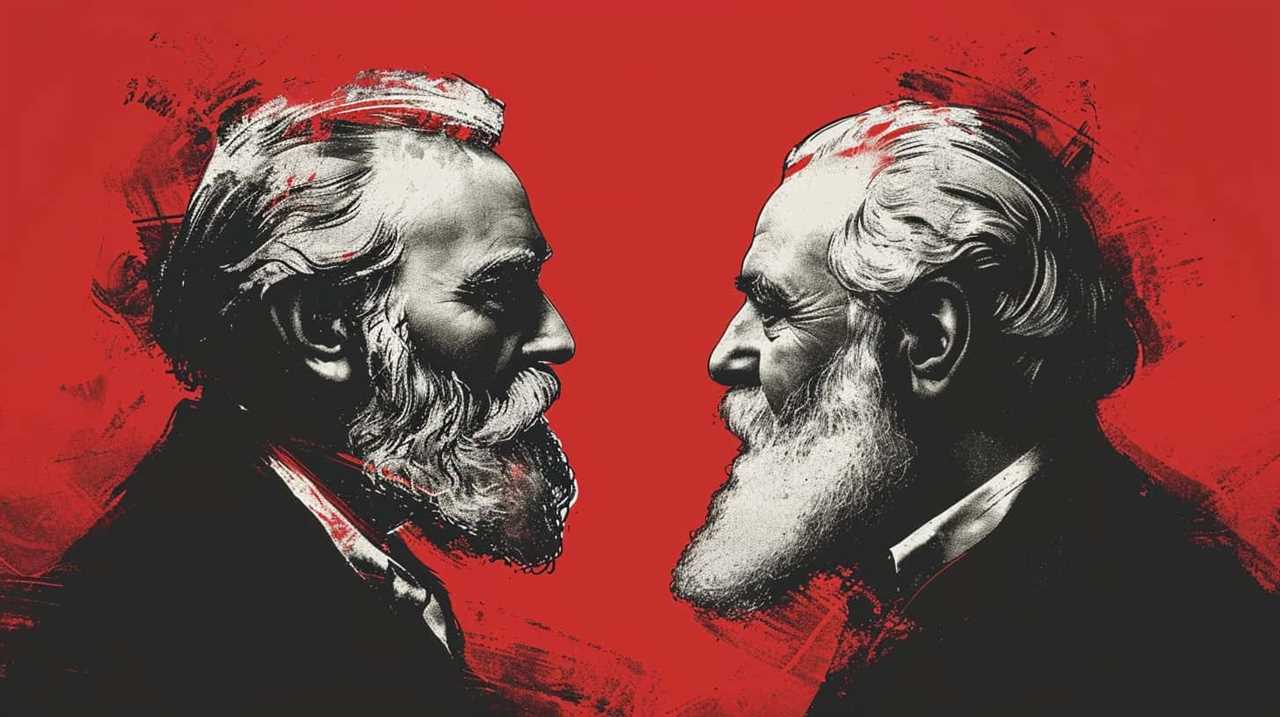We have discovered some intriguing findings from Thomas Mun on mercantilism, and we are thrilled to share them with you!
Did you know that Mun’s ideas on trade and economic policy were highly influential during the 17th century? His works have inspired countless policymakers and economists since then.
In this article, we’ll explore the top 10 best insights from Mun on mercantilism, providing you with valuable knowledge and fresh perspectives.
From the importance of balance of trade to the role of government in promoting trade, Mun’s ideas continue to shape our understanding of economic systems.

So, let’s dive in and discover the wisdom of this renowned economist, as we uncover the secrets behind the success of mercantilist policies.
Key Takeaways
- Balance of trade refers to the difference between a country’s exports and imports, with a positive balance of trade indicating a trade surplus and a negative balance indicating a trade deficit.
- Export surplus plays a pivotal role in driving economic growth by creating employment, fostering innovation, and increasing productivity. It also reflects a country’s competitiveness in the global market and allows for the accumulation of foreign exchange reserves.
- A favorable trade balance, achieved through a trade surplus, brings benefits such as increased employment opportunities, economic growth, and improved living standards. It also allows for the accumulation of foreign currency reserves for various purposes.
- While mercantilism and protectionism aim to promote a favorable balance of trade, they have been criticized by modern economists for potentially hindering global trade, limiting economic growth, and ignoring the importance of factors like competition, innovation, and technological advancement.
The Importance of Balance of Trade
We frequently emphasize the significance of maintaining a favorable balance of trade, as Thomas Mun’s insights on mercantilism highlight. The balance of trade refers to the difference between a country’s exports and imports, and it plays a crucial role in determining a nation’s economic health. A positive balance of trade occurs when a country exports more goods and services than it imports, resulting in a trade surplus. Conversely, a negative balance of trade, or a trade deficit, occurs when a country’s imports exceed its exports.
A trade deficit can have adverse effects on a nation’s economy. It can lead to a depletion of foreign exchange reserves, increase the country’s debt, and put downward pressure on its currency. Additionally, a persistent trade deficit can hinder domestic industries as foreign competition becomes more prevalent.
To address these issues, governments often implement policies aimed at reducing trade deficits and achieving a favorable balance of trade. These measures may include promoting exports, imposing import tariffs, and implementing currency manipulation strategies. By actively managing their balance of trade, countries can protect their domestic industries, stimulate economic growth, and maintain a stable currency.

Now that we’ve discussed the importance of maintaining a favorable balance of trade, let’s delve into Thomas Mun’s definition of mercantilism and how it further elucidates these concepts.
Mun’s Definition of Mercantilism
As we explore Thomas Mun’s insights on mercantilism, it’s essential to understand his definition of this economic theory. Mun defines mercantilism as an economic system that seeks to maximize a nation’s wealth and power by promoting a favorable balance of trade.
According to Mun, a favorable balance of trade occurs when a country exports more goods than it imports, thus accumulating a surplus of gold and silver. This surplus is seen as a sign of economic strength and enables the nation to establish military power and expand its influence.
One of the key aspects of mercantilism, as defined by Mun, is protectionism. Mun argues that governments should implement policies to protect domestic industries and promote exports while limiting imports. These protectionist measures include tariffs, subsidies, and regulations that favor domestic production and restrict foreign competition.

By doing so, Mun believed that nations could ensure a steady flow of wealth into their own coffers and maintain a favorable balance of trade.
Mun’s definition of mercantilism emphasizes the importance of a positive balance of trade and protectionist policies. While his ideas were prevalent during the 17th and 18th centuries, they’ve been widely criticized by modern economists for their potential to hinder global trade and limit economic growth.
However, understanding Mun’s definition of mercantilism allows us to appreciate the historical context and impact of this economic theory.
Role of Export Surplus in Economic Growth
Export surplus plays a pivotal role in driving economic growth. When a country has an export surplus, it means that its exports exceed its imports. This surplus of exports brings in more revenue for the country, which can then be invested in various sectors of the economy. This influx of funds stimulates economic growth by creating employment opportunities, fostering innovation, and increasing productivity.

Export surplus is a reflection of a country’s competitiveness in the global market. It signifies that the country is producing goods and services that are in demand internationally. This not only boosts the country’s export sector but also leads to the development of related industries and supply chains. As a result, the overall economy experiences positive growth.
Furthermore, export surplus allows for the accumulation of foreign exchange reserves. These reserves can be used to stabilize the country’s currency, attract foreign investment, and finance imports of essential goods and technologies. Additionally, export surplus can enhance a country’s bargaining power in international trade negotiations, enabling it to secure more favorable trade agreements.
The Concept of Favorable Trade Balances
The achievement of a favorable trade balance is essential for a country’s economic prosperity. A favorable trade balance occurs when a country’s exports exceed its imports, resulting in a trade surplus. This surplus brings several benefits to a nation, including increased employment opportunities, economic growth, and improved living standards.
By exporting more than it imports, a country creates a demand for its goods and services in the global market, leading to increased production and job creation. Additionally, a trade surplus allows a country to accumulate foreign currency reserves, which can be used to stabilize its currency, invest in infrastructure, or finance development projects.

However, there are also drawbacks to maintaining a favorable trade balance. It can lead to a loss of competitiveness in certain industries, as domestic producers may become complacent due to the lack of foreign competition. Moreover, an excessive trade surplus can result in trade imbalances and strained relations with trading partners.
To achieve a trade surplus, countries employ various strategies, such as promoting exports through subsidies, reducing import barriers, and investing in research and development to enhance competitiveness. In the next section, we’ll examine Thomas Mun’s view on tariffs and protectionism and their role in fostering favorable trade balances.
Mun’s View on Tariffs and Protectionism
Mun’s view on tariffs and protectionism was based on several key arguments.
Firstly, he believed that tariffs could protect domestic industries from foreign competition, allowing them to grow and become more competitive in the long run.

Secondly, he saw protectionism as a means to maintain a favorable trade balance, ensuring that more goods were exported than imported, thus increasing a nation’s wealth.
Lastly, Mun advocated for a strategic trade policy that focused on promoting industries that were vital to national security and economic stability.
These points highlight Mun’s support for tariffs and protectionism as crucial tools for economic growth and security.
Mun’s Tariff Arguments
Why did Thomas Mun advocate for tariffs and protectionism in his views on mercantilism?

Mun believed that tariffs were necessary to promote economic growth and protect domestic industries. He argued that by imposing tariffs on imported goods, a country could stimulate domestic production and ensure a favorable trade balance. Mun saw protectionism as a crucial trade policy tool that would safeguard a nation’s economic interests and prevent the outflow of wealth.
His arguments for tariffs and protectionism were based on the belief that a strong domestic economy would lead to innovation and technological advancement. By protecting domestic industries, Mun believed that a nation could foster an environment conducive to innovation and encourage the development of new ideas and technologies.
This transition into the subsequent section will explore the benefits of protectionism in more detail.
Benefits of Protectionism
As proponents of protectionism, we understand the advantages of tariffs and trade barriers in promoting domestic industries and driving economic growth, as highlighted by Thomas Mun’s insightful views on mercantilism.

Protectionism, in the form of tariffs and trade barriers, can provide several benefits for a nation’s economy. Firstly, it allows domestic industries to flourish by shielding them from foreign competition. This protection gives these industries the opportunity to grow and expand, leading to increased employment opportunities and a boost in economic output.
Additionally, protectionism can help reduce the negative impact of global trade imbalances on a nation’s economy. By implementing tariffs and trade barriers, a country can protect its domestic industries from unfair competition and prevent the loss of jobs and wealth to other nations.
However, it’s important to note that the impact of protectionism on global trade should be carefully considered, as it can lead to trade wars and hinder international cooperation.
Transitioning into the subsequent section about Mun’s trade policy, it’s crucial to analyze his proposed strategies and evaluate their effectiveness in achieving the desired economic outcomes.

Mun’s Trade Policy
Let’s delve into Mun’s trade policy and his perspective on tariffs and protectionism.
Mun believed that a well-crafted trade policy was vital for a nation’s economic growth and prosperity. He advocated for the use of tariffs as a means to protect domestic industries and promote exports. Mun saw tariffs as a way to limit imports and encourage domestic production, thereby creating wealth and employment opportunities within the country.
In terms of protectionism, Mun believed that it was necessary to shield domestic industries from foreign competition. He argued that by protecting local industries, a nation could prevent the outflow of wealth and maintain a favorable balance of trade.
Mun’s trade policy focused on promoting exports and reducing dependence on foreign goods. This approach was aimed at fostering economic self-sufficiency and increasing national wealth through trade. It emphasized the importance of strategic planning and government intervention to ensure a strong and prosperous economy.

The Role of Colonies in Mercantilist Policies
We frequently utilize colonies as vital components of our mercantilist policies. The economic exploitation of colonies plays a crucial role in our pursuit of wealth and power. By establishing colonies, we gain access to valuable resources and markets, allowing us to maximize our profits and maintain a favorable balance of trade. Additionally, colonial trade regulations enable us to control and monopolize the flow of goods, ensuring that our colonies serve as exclusive suppliers of raw materials and consumers of finished products.
To further illustrate the significance of colonies in our mercantilist policies, let us examine the following table:
| Colonies | Resources | Markets |
|---|---|---|
| Africa | Gold, | Slave |
| ivory, | labor | |
| spices | ||
| ———— | ————- | ———– |
| America | Tobacco, | Fur |
| sugar, | ||
| cotton | ||
| ———— | ————- | ———– |
| Asia | Tea, | Silk |
| spices, | ||
| porcelain |
As shown in the table, colonies provide us with access to a diverse range of resources and markets. This allows us to engage in profitable trade and establish a dominant position in the global economy. By strategically exploiting our colonies, we can maintain our economic superiority and ensure the continued growth and prosperity of our nation.
Mun’s Critique of Free Trade
Thomas Mun offers a comprehensive critique of free trade, highlighting its potential drawbacks and implications for our mercantilist policies. While the concept of laissez faire may seem appealing on the surface, Mun argues that it can have negative effects on domestic industries.

One key point to consider is that free trade can lead to the erosion of domestic industries. When foreign goods flood the market due to unrestricted trade, domestic industries may struggle to compete and may ultimately be forced to shut down. This can result in job losses and economic instability within the country.
Another consequence of free trade is that it can undermine national security. Relying heavily on imports can make a country vulnerable to disruptions in the global supply chain. In times of crisis or conflict, a nation with weakened domestic industries may find itself at a disadvantage.
Mun’s critique of free trade sheds light on the potential pitfalls of embracing laissez faire policies. While free trade can bring benefits in terms of increased variety and lower prices for consumers, it’s crucial to consider the long-term impact on domestic industries and national security.
Striking a balance between open trade and protecting domestic industries is essential for maintaining economic stability and innovation.

The Role of Government in Promoting Trade
Moving forward from our previous discussion on the potential drawbacks of free trade, it is important to explore the significant role that government plays in promoting trade. Government intervention in trade promotion is crucial for fostering economic growth and ensuring the well-being of a nation’s industries and citizens.
One of the key ways in which governments promote trade is through the implementation of trade policies and regulations. These policies aim to protect domestic industries from unfair competition and create a level playing field for businesses. Governments often impose tariffs, quotas, and subsidies to regulate imports and exports, safeguarding domestic markets and promoting the growth of domestic industries. For example, a government may impose tariffs on certain imported goods to protect local manufacturers and encourage consumers to buy domestically produced goods.
Furthermore, governments play a vital role in negotiating and signing trade agreements with other nations. These agreements help to reduce trade barriers, such as tariffs and quotas, and facilitate the exchange of goods and services between countries. By participating in international trade agreements, governments can create new opportunities for businesses to expand their markets and access foreign consumers.
To illustrate the importance of government intervention in trade promotion, we have created the following table:

| Government Intervention Strategies | Examples |
|---|---|
| Tariffs | Imposing taxes on imported goods to protect domestic industries. |
| Quotas | Restricting the quantity of imported goods to safeguard domestic markets. |
| Subsidies | Providing financial assistance to domestic industries to promote competitiveness. |
| Trade Agreements | Negotiating and signing agreements to reduce trade barriers and enhance international trade. |
Mercantilism and National Power
When discussing mercantilism and national power, it’s important to consider the economic competition and dominance that this system entails.
Mercantilism aims to maximize a nation’s exports and minimize its imports, creating a favorable balance of trade. By doing so, countries can accumulate wealth, strengthen their domestic industries, and ultimately enhance their national power on the global stage.
This approach to trade has significant implications for the dynamics of global commerce and the relationships between nations, as each country strives to secure its economic interests and maintain its position of power.
Economic Competition and Dominance
We actively compete with other nations in order to establish economic dominance and bolster our national power through the principles of mercantilism. This approach to economic competition is rooted in the belief that economic growth and national power are closely intertwined.

By implementing strategic trade policies, we aim to maximize exports and minimize imports, ensuring a favorable balance of trade. This allows us to accumulate wealth and resources, which in turn strengthens our economy and enhances our national power.
Additionally, through mercantilist practices such as tariffs and subsidies, we can protect domestic industries and promote innovation, driving further economic growth and solidifying our competitive advantage on the global stage.
In a world where innovation is paramount, our commitment to mercantilism enables us to stay at the forefront of economic competition and maintain our position of dominance.
Impact on Global Trade
Through our implementation of mercantilist policies, we actively shape the impact of global trade on our national power. Mercantilism, with its focus on maximizing exports and accumulating wealth, has a profound influence on economic development.

By prioritizing the acquisition of precious metals and establishing colonies, mercantilism encourages imperialism as a means to secure resources and markets. This expansionist approach allows us to control key trade routes, establish monopolies, and gain a competitive advantage over other nations.
Our dominance in global trade directly contributes to our national power by increasing our economic strength and influence.
Mercantilism’s emphasis on protecting domestic industries through tariffs and trade restrictions also safeguards our economic interests and fosters innovation.
As we continue to implement mercantilist policies, we’ll further shape the impact of global trade on our nation, solidifying our position as a global economic powerhouse.

What are some of the Key Insights from Thomas Mun on Mercantilism that are Reflected in his Quotations?
Thomas Mun’s quotations on mercantilist ideals highlight the importance of a nation’s balance of trade, the accumulation of precious metals, and the connection between a strong economy and a powerful military. His insights shed light on the core principles of mercantilism, shaping economic policies for centuries to come.
Mun’s Influence on Mercantilist Policies
Mun’s impact on mercantilist policies can be seen in the adoption of his ideas by policymakers. His theories on trade and economic development influenced the way governments approached their economic policies during the mercantilist era.
Here are some key ways in which Mun’s ideas shaped mercantilist policies and had a significant impact on the economy:
- Trade Regulation: Mun advocated for government intervention in trade to protect domestic industries and promote exports. His ideas heavily influenced the implementation of tariffs, quotas, and other trade restrictions by mercantilist governments. These policies aimed to maintain a favorable balance of trade and stimulate economic growth.
- Colonial Expansion: Mun believed that acquiring colonies was crucial for a nation’s economic prosperity. His ideas on colonial expansion influenced mercantilist policies that focused on establishing colonies to secure raw materials, establish captive markets, and expand trade networks.
Frequently Asked Questions
How Did Thomas Mun’s Ideas on Mercantilism Influence the Policies of His Time?
Thomas Mun’s ideas on mercantilism greatly influenced the policies of his time, shaping the economic impact of nations. His emphasis on promoting exports, protecting domestic industries, and accumulating wealth through trade guided policy decisions and fostered economic growth.
What Were the Main Criticisms of Free Trade According to Thomas Mun?
Thomas Mun’s insights on mercantilism emphasized the role of colonies in promoting economic growth. According to him, free trade had several criticisms, including the loss of domestic industries and the accumulation of wealth by foreign nations.

How Did the Concept of Favorable Trade Balances Shape Economic Growth During the Mercantilist Era?
Trade imbalances played a crucial role in shaping economic development during the mercantilist era. By prioritizing favorable trade balances, nations focused on exporting more than importing, leading to increased wealth and power.
What Role Did Colonies Play in the Implementation of Mercantilist Policies?
Colonies played a crucial role in implementing mercantilist policies, as they provided a source of raw materials and markets for the mother country. This had a significant impact on global trade, allowing for the accumulation of wealth and economic dominance.
How Did Thomas Mun Define Mercantilism and What Were Its Main Principles?
Thomas Mun defined mercantilism as an economic policy aimed at accumulating wealth through favorable trade balances. His insights emphasized the importance of colonies in achieving this goal and criticized free trade. Mun’s ideas continue to influence economic thinking today.
Conclusion
In conclusion, Thomas Mun’s insights on mercantilism provide a valuable understanding of the economic principles and policies of the time.

His emphasis on the importance of balance of trade, the role of government in promoting trade, and the link between mercantilism and national power shed light on the motivations and strategies of the era.
Mun’s influence on mercantilist policies shaped the economic landscape of his time and influenced future generations.
His ideas continue to spark debate and analysis in the field of economics.
Lauren’s talent in writing is matched by her passion for storytelling. Her love for books and deep understanding of culture and entertainment add a distinct flavor to her work. As our media and press contact, Lauren skillfully bridges the gap between afterQuotes and the broader media landscape, bringing our message to a wider audience.










